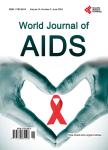Delay in Early Infant Diagnosis and High Loss to Follow-Up among Infant Born to HIV-Infected Women in Ethiopia
Delay in Early Infant Diagnosis and High Loss to Follow-Up among Infant Born to HIV-Infected Women in Ethiopia作者机构:Antiviral Research Center School of Medicine University of California San Diego San Diego USA Department of Health Service Management Institute of Public Health University of Gondar Gondar Ethiopia Department of Reproductive Health Institute of Public Health University of Gondar Gondar Ethiopia Department of Family and Preventive Medicine Division of Biostatistics and Bioinformatics University of California San Diego San Diego USA Division of Infectious Disease School of Medicine University of California San Diego San Diego USA
出 版 物:《World Journal of AIDS》 (艾滋病(英文))
年 卷 期:2014年第4卷第4期
页 面:402-412页
学科分类:1002[医学-临床医学] 100201[医学-内科学(含:心血管病、血液病、呼吸系病、消化系病、内分泌与代谢病、肾病、风湿病、传染病)] 10[医学]
主 题:HIV Infant Delay Loss to Follow-Up PMTCT Ethiopia
摘 要:Background: Many HIV-infected infants and children die from HIV related causes without their HIV status being known or receiving HIV care. All HIV exposed infants should be tested by Dried Blood Spots (DBS)-PCR before or at 6 weeks of age. Testing is a crucial step to facilitate early access to antiretroviral treatment (ART). However, studies that assess the level of use and implementation of HIV DNA testing in Ethiopia are lacking. Objective: To investigate the rate of early infant diagnosis (EID), defined as having blood drawn for HIV DNA-PCR testing, and predictive factors of EID among infants born to HIV infected women. Method: A multicentre retrospective cohort study was conducted from April to June 2012 in three public hospitals and three health centers, in Northwest Ethiopia. Mother-infant pairs were followed from delivery until the time of the HIV diagnostic test. Data were captured using standardized forms. The time-to-diagnostic test was estimated using Kaplan-Meier estimators. Factors associated with EID were evaluated using logistic regression. Result: Of the 266 HIV-exposed infants identified from the health facilities, only 109 (41.0%) infants had early HIV DNA-PCR tests. The median age at the time of HIV diagnostic testing was 60 days (95% CI: 47 - 73 days), and the median turnaround time between blood draw for DNA-PCR testing to delivery of a test result to the respective health facility was 36 days (95% CI: 33 - 40 days). A total of 35 (13.2%) infants were diagnosed with HIV infection. The predictors of EID were the mother having prenatal care, maternal receipt of ART during pregnancy and place of birth. Conclusion: Three out of five HIV-infected women did not bring their infant for HIV testing during the recommended 6 week interval after birth. Special attention is required for infants born to HIV-infected women who did not receive ART or delivered at home or a private health facility to ensure early infant diagnosis, reduce loss to follow-up and p



